Navarinoinvestment:
Something very ''big'' coming up in Iklaina...
''The transition from a world without states to a world dominated by states is one of the most fascinating chapters in human history. The purpose of the Iklaina Archaeological Project (IKAP) is to investigate how this transition happened in ancient Greece.
IKAP is an interdisciplinary research project in the area of Pylos, Greece, carried out under the auspices of the Athens Archaeological Society and the direction of Professor Michael Cosmopoulos of the Department of Anthropology and Archaeology at the University of Missouri at St. Louis. Situated at a strategic location overlooking the Ionian Sea, Iklaina appears to have been an important district capital of the Late Bronze Age (ca. 1600-1100 BC). This is the period also known as “Mycenaean” and famous for such mythical sagas as the Trojan War.
The general objective of the project is to provide a detailed and thorough understanding of the relationship between center and periphery in the Greek world and shed new light on the localized developments that shaped the birth and operation of early Greek states. The project has already produced unexpected finds in the form of monumental buildings that may belong to a Mycenaean palace, frescoes, pottery, metal finds, as well as an inscribed tablet. These surprising discoveries challenge the current model of chiefdom-to-state evolution and suggest that until now we had been missing an important piece of the puzzle: the new evidence suggests that bureaucracy and literacy appeared earlier than what was previously thought and that they were not restricted to the major palatial centers. Our long term goal is to develop general models applicable to state formation in later periods of Greek history and in other parts of the world.''
The dominant feature of the site is a massive rectangular terrace constructed with “Cyclopean” limestone blocks. Over the course of the centuries it has sustained a lot of damage, but the heaviest damage was caused by a mechanical bulldozer that destroyed its central part in the 1960s or 1970s.
The terrace measures 8 x 23m, with its long axis oriented southwest-northeast and features the offsets known from Cyclopean terraces at other Mycenaean sites (J. Wright, “Mycenaean Palatial Terraces”, AthMitt 95, 1980, 59-86).

Plan
of the Cyclopean Terrace and adjacent walls. The corridor is shown in
dark grey, the stones of the ramp in light grey, the possible courtyard
in stipple.
Unfortunately, the part of CT Building that used to stand on top of the terrace is now forever gone, but on the flat area to the south we are uncovering foundation walls that belonged to that building. The rooms are separated from the terrace by a a corridor running in a SW.-NE. direction, 0.90-1.2 m. wide and preserved to a length of 10.50 m, from the southwest end of the terrace to the point where the terrace was destroyed by the bulldozer. A preliminary impression is that the function of the corridor was to lead from the lower levels to the east of the terrace up to the rooms on the flat area. This is based on the fact that several rooms exist to the south and east of this corridor.
The small rooms to the south of the corridor (T1-T3) were used as cellars for storage, but the rooms that originally would have stood on top of these cellars were decorated with wall paintings. Numerous pieces of frescoes have been found here; their study is still underway, but recognizable representations include at least two female figures (perhaps part of a procession) and a naval scene. Immediately to the south of Unit T there is an apsidal Unit, Unit S. A pebble floor found in the south part of room S2, represents the floor of this room, on which sat an early Mycenaean bowl; in the center of the room and on this floor there was an irregular burned area, approximately 85 cm. in diameter and 48 cm. thick, which represents the remains of a hearth. At a distance of 4.60 m. to the northeast of Unit S there is another unit, Unit Y; this Unit has been only partially excavated, but it appears that it had two rooms, in one of which there is a flight of steps. In the west end of this room there is a stepped ramp constructed of twelve large flat stones, which leads from Unit S up to the terrace and into space Y2. The finds from all these rooms include fine kylikes, bowls, and goblets, as well as storage vases, that can dated to the LH II-LH IIIA1 period.
A large outdoor area opens up on the terrace, to the east, south, and southeast of room Y2. This area is devoid of artifacts and at spots preserves patches of a floor made of a layer of reddish clay, which may suggest that it was used as a courtyard. This floor is supported by a thick artificial fill made of red soil with dense pebble and small stone inclusions; this fill becomes thicker towards the south/southwest, where the ground slopes more. Its purpose was to create an artificial flat area over the sloping ground in the sw. part of this open area. The size and plan of this open area cannot be established yet, but it appears to have been bordered to the west by rooms Y1-Y2, to the north by the CT Unit, to the south by walls ST-001 to ST-004 and to the east by Units X and Z.
Another building that bordered the open area to the east is Unit Z. In reality, there are two separate rooms, partially preserved: Z1 is defined by walls CT-010, CT-011, and CT-013 and Z2 is defined by walls CT-012 and CT-014. These rooms have tentatively been grouped into one unit, because of the similarities in their orientation and construction manner, as the associated walls are made of similar rubble and employ ashlar blocks as corner antae (one anta block preserves cutting indicative of a wooden armature. The thickness of these walls suggests that these rooms may have supported more than one storey.
Between Units X and Z there existed a shaped limestone slab paving, partly constructed of orthostate slabs in second use. To the ne. of rooms Z1 and Z2 we cleared a paved area, of which a long and narrow patch is preserved.
- Buildings to the south of the Cyclopean Terrace
- Drains ζ and η with the se. corner of Unit X from the south
- Fragments of frescoes and offering table from the CT Building
- Plan of the Cyclopean Terrace and adjacent walls. The corridor is shown in dark grey, the stones of the ramp in light grey, the possible courtyard in stipple
- South of the CT building showing areas S, T, and Y
- The Cyclopean Terrace from the north/northeast showing plow damage
- The northwest corner of the Cyclopean Terrace
- The steps of the CT Building
- The western offset of the Cyclopean Terrace Wall
- via
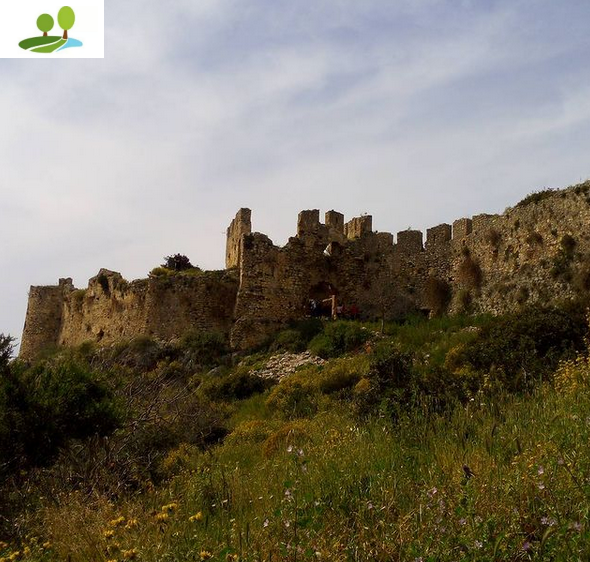



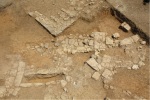
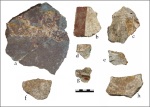
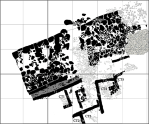


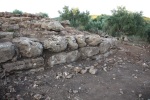
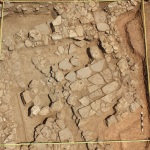
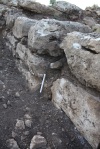
Δεν υπάρχουν σχόλια :
Δημοσίευση σχολίου